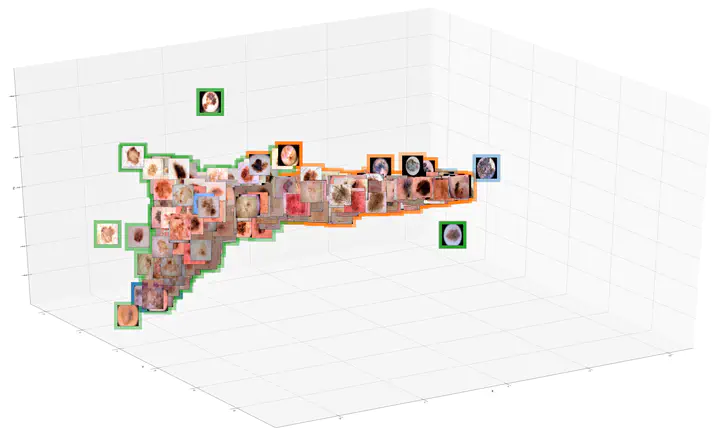 Photo by rawpixel on Unsplash
Photo by rawpixel on Unsplash
GEBI
Global Explanations for Bias Identification

Global explanations for discovering bias in data
Agnieszka Mikołajczyk, Michał Grochowski, Arkadiusz Kwasigroch [paper]
Abstarct: In the paper, we propose attention-based summarized post-hoc explanations for detection and identification of bias in data. We propose a global explanation and introduce a step-by-step framework on how to detect and test bias. Then, the bias is evaluated with proposed counterfactual approach to bias insertion. Because removing the unwanted bias is often a complicated and tremendous task, we automatically insert it, instead. We validate our results on the example of the skin lesion dataset. Using the method, we successfully identified and confirmed part of the possible bias-causing artifacts in dermoscopy images. We confirmed that the commonplace black frames in the training dataset images have a strong influence on the Convolutional Neural Network’s prediction. After artificially adding a black frame to all images, around 22% of them changed the prediction from benign to malignant. We have shown that bias detection is an important step of making more robust models, and we discuss how to improve them
Simple framework
Three steps for explainability:
- Discover bias with global explanations [code]
- Insert bias to all images in the dataset [code]
- Check how predictions changed
How to detect bias?
-
Step 0. Select samples for analysis.
-
Step 1. Compute attention maps for the samples of one class.
-
Step 2. Normalize and preprocess both input samples and accompanying attention maps in the same manner.
-
Step 3. Reduce the dimension of each input sample and relevance map with dimension reduction algorithm, for instance, with Isomap
-
Step 4. Concatenate each reduced sample with a relevant reduced attention map.
-
Step 5. Perform spectral clustering on reduced vectors.
-
Step 6. Visualize and analyze obtained clusters.
-
Step 7. Formulate and test the hypothesis with bias insertion algorithm
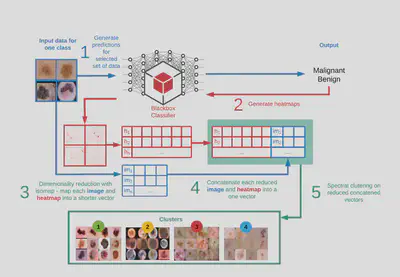
Bias in skin lesion dataset
With our proposed method, we have identified four different clusters. Each cluster reveals unique characteristics in the look of analyzed data set, related with the skin tone, skin lesions, but also with the presence of the unwanted artifacts. The first and the second cluster seem to group images based on the skin lesions similarity, which is a welcomed result in this case. On the contrary, the third cluster mostly gathers images with round or rectangular black frames. The last, fourth cluster contains mostly light skin lesions, very often with a visible ruler. The proposed method is semi-automated, so a field expert should analyze the clusters. In this case, we focused our attention on clusters 3 and 4, where some additional artifacts grouped those images. Hence, we could formulate a hypothesis that black frames and ruler marks might cause possible bias in models. To check if those features have a significant influence on the prediction, we conducted another experiment: inserting possible bias and testing its influence.
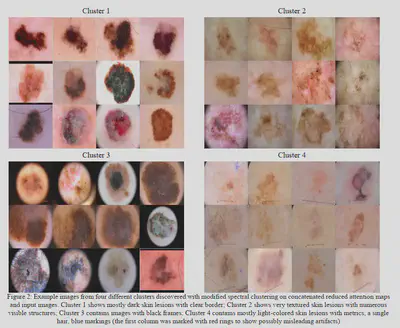
Bias insertion
To test how the prediction will change if feature on the image is present, we propose to compare models outputs for the same image with and without the given feature. Because removing artifacts from the images is very complicated task, we have decided to insert it, instead. We wanted to mimic the real artifacts that we found in the dataset, as well as to add a new one for comparison.
-
Black frames were added in the same way to all images, without any variations in size and position. Frames can be commonly found in numerous images, and are often recognized as unwanted artifacts
-
Rule marks were prepared beforehand and placed on the image in slightly different sizes, angles, and positions. Rulers are usually used by a doctor to show the size of a skin lesion on the dermoscopic image.
-
Red circles cannot be naturally found in the ISIC archive, SD-198, and Derm7pt datasets. For a clear comparison, we have also placed those markings. The single red circle was placed randomly in the image, both within the skin and lesion areas.
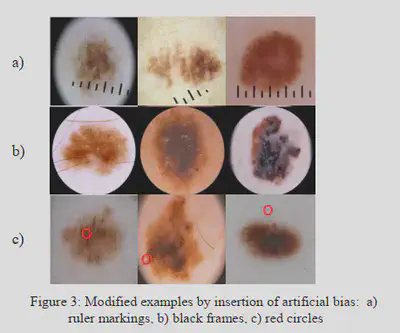
Measuring bias influence
After we modified the dataset by placing in images selected artifacts, we began testing our hypothesis by asking a question: Are those artifacts causing bias in model’s performance? To answer this question we measured how predictions will change depending on the presence of the artifacts. In our case, we checked what will happen if we add to all images: black frames, black rural, and red circles.
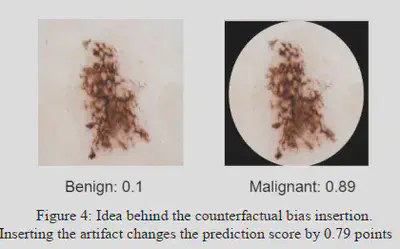
Results
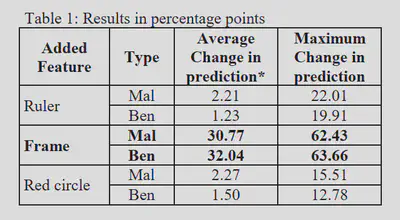
Codes
Codes can be found in notebook directory. Images used for experiments are provided in the data directory. Images are already preprocessed with Attention Map Generation method.
- GEBI notebook - easy-to-follow script of implemented GEBI method on the example of skin lesions. For quick calculations we provided precalculated attribution maps.
- SpRay notebook - easy-to-follow script of implemented original SpRay method on the example of skin lesions. For quick calculations we provided precalculated attribution maps.
- modofied SpRay notebook - easy-to-follow script of implemented modified SpRay method with additional Isomap dimensionality reduction on the example of skin lesions. For quick calculations we provided precalculated attribution maps.
Acknowledgments
The research reported in this publication was supported by Polish National Science Centre (Grant Preludium No: UMO-2019/35/N/ST6/04052). The authors wish to express their thanks for the support.